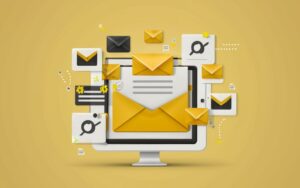When you set out to create an email marketing strategy, it’s important to understand that behind everything lies a well-crafted plan designed to increase brand awareness, engage subscribers, and deliver measurable results. Whether you’re new to email marketing or just want to refine your approach, this article provides expert-verified answers to key questions about effective email campaigns. You’ll learn how to tailor your strategy, maximize deliverability, and ensure that every email you send contributes to the success of your business. So, why should you ask ‘what is your goal?’ before creating an email marketing strategy? Let’s dive into the best practices for creating your email marketing plan and discover why this article is worth your time.
What is an email marketing campaign, and why does it matter?
So, why should you ask ‘what is your goal?’ before creating an email marketing strategy? An email marketing campaign is a structured series of emails designed to communicate specific messages to your audience. Marketing emails can serve a wide range of purposes, from building brand awareness to driving conversions. A well-executed campaign performs better when aligned with your overall business strategy and segmentation. By creating your email marketing plan thoughtfully, you’ll set yourself up for success.
How do you create an email marketing strategy from scratch?
Before creating an email marketing strategy, you need a clear understanding of your goals. What do you want to accomplish? Whether it’s building customer engagement or boosting conversions, defining smart goals at the outset will guide your email marketing efforts. It’s important to have data to create a personalized approach. Creating segments based on demographics, purchasing behavior, or even the region a contact resides in will ensure your emails are relevant to your audience.
What role does segmentation play in email marketing success?
Segmentation is the key to sending the right message to the right person at the right time. An example of appropriate segmentation would be a furniture retailer who sends weekly emails to subscribers based on their previous interactions with the brand. Sending a different discount email to certain contacts, or sending a discount email to certain contacts based on the region, will boost engagement and click-through rates. Using segmentation ensures that your emails are personalized and not just generic messages.
What are the key components of an effective email campaign?
A successful email campaign includes several key elements: a clear subject line, a call-to-action (CTA), and engaging content. The subject line is critical because it directly impacts the open rate of your emails. A good subject line grabs attention and compels the reader to click. Once opened, every email you send should include a CTA that encourages the subscriber to take a specific action, whether it’s making a purchase or signing up for a newsletter. Lastly, the content must resonate with the recipient and be aligned with your email marketing goals.
How does personalization improve the effectiveness of your email marketing?
Personalization plays a vital role in improving customer engagement and increasing brand awareness. When you tailor your strategy to the individual needs of your audience, your emails will feel more relevant and personal. For example, a CRM can help you use email personalization techniques to send emails based on the customer’s last purchase from your company. Personalizing the content and offers can significantly improve your email engagement and conversion rates.
What should you do before sending marketing emails?
Before proceeding to send them marketing emails, ensure that you have a robust email list. This means verifying that all your contacts have opted in and checked to receive marketing emails from your company. It’s also essential to have your email service provider (ESP) ready to support your campaigns and ensure deliverability. Make sure your sender reputation is solid, and use proper email authentication methods, such as attaching your logo to your messages, so your emails don’t end up in the spam folder.
How do you measure the success of your email campaigns?
To evaluate the success of your email marketing efforts, you’ll need to track key metrics. Open rates, click-through rates, and the effectiveness of your email marketing campaigns should be consistently monitored. Additionally, you can generate a marketing report using the data collected from your email service provider. If your emails are personalized and segmented, you’ll likely see a higher success rate. When a customer makes a purchase from your company or completes a CTA, it’s a good indication that your email strategy is working.
What are the benefits of using email marketing templates?
Email marketing templates can simplify content creation and ensure consistency across your campaigns. Templates also save time and allow you to maintain brand identity, as they include your company’s style and branding elements, like your logo. Whether you’re sending newsletters, welcome emails, or discount offers, templates streamline the process and help maintain the effectiveness of your email marketing strategy.
How does a subject line influence open rates?
Your subject line can make or break your email marketing campaign. It’s one of the first things a subscriber sees, so you want to ensure it grabs attention. Including action words, personalization, or a sense of urgency can increase open rates. For example, “Exclusive discount just for you!” or “Don’t miss out on this limited-time offer!” are subject lines that perform well. Keep it concise and relevant to boost your email campaign’s overall effectiveness.
What types of emails should you include in your email marketing strategy?
There are several types of emails that you should consider adding to your email marketing strategy. First, the welcome email is essential for setting the tone with new subscribers. Second, newsletters keep your audience informed and engaged. Lastly, promotional emails, such as sending a discount email to certain contacts, can drive conversions. Each email type serves a specific purpose, contributing to the success of your overall strategy.
How does segmentation help boost the success of your email campaigns?
So, why should you ask ‘what is your goal?’ before creating an email marketing strategy? By creating your email marketing strategy with segmentation at the forefront, you increase the chances that your emails will resonate with recipients. Segmentation allows you to send emails based on customer behavior, such as when a customer makes a purchase or subscribes to your newsletter. With segmentation, your marketing emails feel more personal and relevant, which leads to higher open and click-through rates.
How do you avoid the spam folder?
Deliverability is a critical factor in email marketing. If your emails are being flagged as spam, they’re not reaching your audience, and your efforts are wasted. Ensure that your emails are authenticated by using proper email authentication methods and that your subscribers have opted in to receive marketing emails. Avoid spammy language in the subject line, and always include a clear CTA. Also, ensure that your ESP is reputable and that your sender reputation remains strong.
Myth Busting: Debunking Common Email Marketing Misconceptions
Email marketing is surrounded by numerous myths and misconceptions that can often mislead businesses trying to develop effective strategies. Let’s address and clarify three common myths to set the record straight, so your email marketing efforts can stay relevant to the overall business.
Myth 1: “I can send marketing emails to anyone, as long as I have their email.”
Reality: Before creating an email marketing campaign, you must ensure that all recipients have explicitly opted in. It’s not just about having an email address—subscribers need to have the box checked to receive marketing emails willingly. Without this, you risk damaging your sender reputation and getting flagged as spam. Implementing a proper form of email authentication that attaches to each message also helps ensure deliverability and keeps your emails out of spam folders.
Myth 2: “All I need is a great subject line, and my email will succeed.”
Reality: While a catchy subject line is essential, it’s just one part of a successful email campaign. Every email includes a CTA (call-to-action) that guides the reader toward desired outcomes, like making a purchase or signing up for a newsletter. Moreover, your email marketing strategy be relevant to your audience. It should involve segmentation, personalization, and a compelling offer, not just a well-written subject line.
Myth 3: “Sending weekly emails to your subscribers is too much.”
Reality: Many believe that sending weekly emails to your subscribers will lead to unsubscribes, but the truth is, frequency depends on the quality and relevance of your content. As long as your emails provide value and are relevant to the overall business goals, regular communication is beneficial. Tools like HubSpot, chegg.com, and brainly.com can provide insights into email performance and help you tailor your frequency for optimal engagement.
By understanding these myths, you’re better equipped to make informed decisions and avoid common pitfalls in your email marketing strategy. Make sure your efforts align with your overall goals and resonate with your audience, ensuring long-term success.
Case Study: Implementing Email Authentication for Improved Deliverability
Real-World Application: ABC Tech’s Email Marketing Success
ABC Tech, a growing SaaS company, was experiencing low email deliverability and poor open rates despite having a well-segmented email list and engaging content. Before creating an email marketing overhaul, they recognized that their messages often landed in the spam folder. Their team knew they needed to address the problem behind the strategy and take a more technical approach.
They decided to implement a form of email authentication using DKIM and SPF records, ensuring that each email had proper verification when sent. Additionally, they set in their email marketing strategy a new practice of adding personalized content in every email newsletter. This includes a CTA that reads “Get the answers you need” to encourage engagement.
Within two months, they saw a 25% increase in deliverability, which resulted in a 15% rise in open rates and a 10% boost in click-through rates. This example of which email marketing techniques can enhance deliverability shows that technical changes, alongside personalized content, are crucial for success.
So, why should you ask ‘what is your goal?’ before creating an email marketing strategy? This case shows how using proper messages to authenticate your emails can make a tangible difference in campaign outcomes.
Expert Comment by Dr. Laura Michaels, Digital Marketing Strategist – before creating an email marketing campaign
“Before creating an email marketing strategy, it’s critical to define your audience and goals. This allows you to set in your email marketing efforts with precision and focus. A vital component is ensuring that a form of email authentication attaches to every message, boosting deliverability and trust. As you dive into the email marketing concept, think of it like preparing for a big exam. It’s like when you study with Quizlet and memorize flashcards containing essential marketing terms. Knowing the key elements and how to apply them is crucial.
When creating an email marketing strategy?to boost engagement, you also need to include a robust segmentation strategy. This helps your email marketing strategy?to understand and anticipate what your audience needs. One question you’re looking to answer is: How can I provide value to my subscribers? Personalization is the key to crafting an email asking for interaction. A well-timed offer, for instance, would be an example of providing value at the right moment, ensuring the company and submits real-time, relevant offers. Never stop evolving your strategy based on new questions arising from data and customer feedback.”
Key takeaways for creating an email marketing strategy
- Create an email marketing strategy that aligns with your overall business goals.
- Segment your email list based on customer behavior, demographics, or purchase history.
- Personalize your emails to increase customer engagement.
- Use clear and compelling subject lines to boost open rates.
- Include a strong CTA in every email to drive action.
- Monitor key metrics such as open rates, click-through rates, and conversions to assess the effectiveness of your email marketing efforts.
- Use email marketing templates to save time and maintain consistency in your branding.
- Ensure your emails are properly authenticated to avoid being flagged as spam.
By following these guidelines, you can create an effective email marketing strategy that delivers measurable results and supports your overall business strategy. Whether you’re looking to increase brand awareness, boost customer engagement, or drive conversions, email marketing can be a powerful tool for your business. Here’s why should you ask ‘what is your goal?’ before creating an email marketing strategy.




